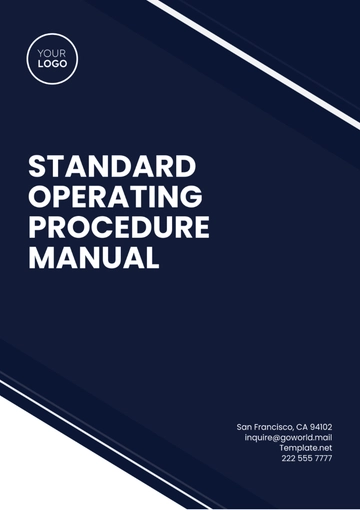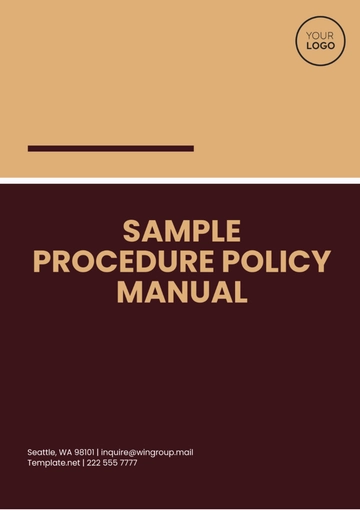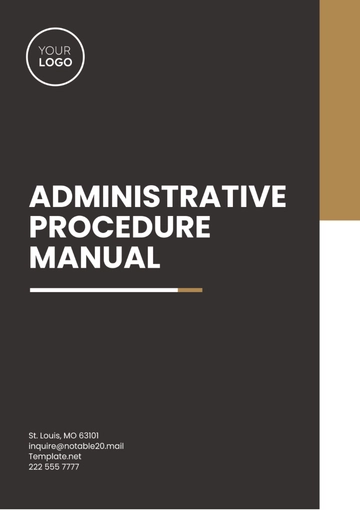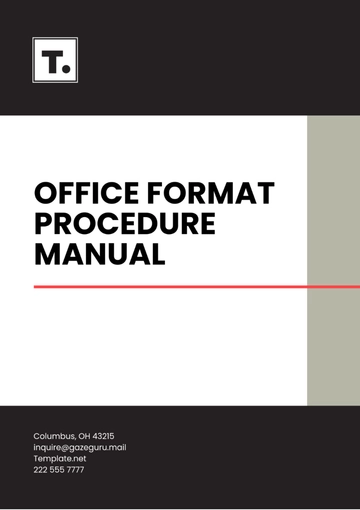Free Financial Procedures Training Manual

1. Introduction and Overview
Welcome to [Your Company Name]'s Financial Procedures Training Manual. This document is a comprehensive guide designed to articulate the financial policies, practices, and standards that govern our operations. As a pivotal resource, it ensures that our financial activities align with the strictest professional and legal standards, particularly those prevalent in the United States financial sector. This manual serves not only as an educational tool for new employees but also as a reference for our seasoned staff, reinforcing our commitment to financial integrity and accountability.
The scope of this manual encompasses various financial processes and practices, including but not limited to accounting principles, budgeting, expense management, revenue handling, and compliance with regulatory requirements. It is crafted to provide clarity and direction in our financial operations, aiming to standardize procedures across all departments and levels within [Your Company Name].
2. Roles and Responsibilities
This section of the Financial Procedures Training Manual details the specific roles and responsibilities of key personnel involved in the financial operations at [Your Company Name]. Understanding the duties and expectations of each role is crucial for maintaining an organized and efficient financial management system. Below are the primary financial positions and their respective responsibilities:
Role | Responsibilities |
Accountant |
|
Financial Manager |
|
Auditor |
|
Accounts Payable Clerk |
|
Accounts Receivable Clerk |
|
Financial Analyst |
|
3. Accounting Policies and Principles
At [Your Company Name], our financial operations are governed by a strict adherence to established accounting policies and principles. This ensures not only compliance with legal standards but also fosters transparency and consistency in our financial reporting. Our accounting practices align with the Generally Accepted Accounting Principles (GAAP) as the primary framework, supplemented by relevant aspects of the International Financial Reporting Standards (IFRS) where applicable.
Section | Policy/Principle | Details |
Compliance with GAAP | Accrual Basis of Accounting | Revenues and expenses are recorded when they are earned or incurred, irrespective of cash transactions. |
Consistency | Ensures uniform financial reporting across periods for comparability. | |
Materiality | All significant financial information is accurately reported. | |
Revenue Recognition | GAAP Guidelines | Revenue is recorded when it is realized or realizable, and earned. |
Expense Recognition | Matching Principle | Expenses are recognized when incurred, matched with related revenues. |
Asset Valuation | Historical Cost and Depreciation | Assets are recorded at historical cost and depreciated over their useful lives. |
4. Budgeting and Forecasting
Budgeting and forecasting are critical components of [Your Company Name]'s financial planning process. These practices ensure effective allocation of resources and anticipation of future financial needs. The following subsections outline the instructions and procedures for preparing, reviewing, and approving budgets and financial forecasts.
Budget Preparation
Data Collection: Gather historical financial data and current market trends.
Departmental Input: Involve department heads in setting realistic budget goals.
Drafting Budget: Compile and draft an initial budget incorporating all inputs.
Forecasting
Trend Analysis: Analyze past financial performance to predict future trends.
Market Analysis: Consider external factors like market conditions and economic indicators.
Scenario Planning: Develop multiple financial scenarios based on various assumptions.
Review Process
Internal Review: Conduct initial reviews by department heads and finance team.
Revision: Make necessary adjustments based on feedback.
Approval
Senior Management Review: Present the final budget and forecasts to senior management for approval.
Board Approval: If required, submit to the board for final approval.
Implementation and Monitoring
Distribution: Circulate the approved budget and forecasts to all departments.
Regular Monitoring: Track actual performance against budgeted figures periodically.
5. Expense Management and Reporting
Effective management and transparent reporting of business expenses are crucial for the financial integrity of [Your Company Name]. This section outlines the guidelines for handling various types of expenses, focusing on travel, procurement, and reimbursement.
General Expense Policy
Policy Compliance: Adherence to the company's expense policy is mandatory for all employees.
Documentation: Require detailed documentation and receipts for all expenses.
Travel Expenses
Pre-Approval: All travel must be pre-approved by the relevant manager.
Allowable Expenses: Define what constitutes allowable travel expenses, including accommodation, meals, and transport.
Expense Reporting: Timely submission of travel expense reports with required documentation.
Procurement Procedures
Vendor Selection ↓ Purchase Authorization ↓ Record Keeping |
Reimbursement Policies
Eligibility: Clearly define what expenses are eligible for reimbursement.
Submission Process: Outline the process for submitting reimbursement claims.
Timely Reimbursement: Ensure prompt processing and reimbursement of valid claims.
Reporting and Review
Regular Audits: Conduct regular audits of expense reports to ensure compliance.
Analysis and Reporting: Regularly analyze and report on company-wide expense trends.
6. Internal Controls and Audit Compliance
Revenue recognition and management are key aspects of [Your Company Name]'s financial operations, ensuring accuracy and compliance in financial reporting. The following policies govern how we recognize and manage revenue.
Revenue Recognition Policy
Criteria for Recognition: Revenue is recognized when earned, deliverables are completed, and collection is reasonably assured.
Compliance with GAAP: Adhere to Generally Accepted Accounting Principles for revenue recognition.
Invoicing Procedures
Timely Invoicing: Issue invoices promptly upon delivery of goods or services.
Accuracy: Ensure invoices accurately reflect the terms of the contract.
Payment Processing
Setting Payment Terms ↓ Receipt of Payment ↓ Acknowledgement of Payment |
7. Financial Reporting and Documentation
Effective financial reporting and documentation are fundamental to [Your Company Name]'s ability to provide accurate and transparent insights into our financial health. The following six-step procedure ensures the meticulous preparation and maintenance of crucial financial reports, such as balance sheets, income statements, and cash flow statements, vital for strategic decision-making and compliance.
Data Collection ↓ Initial Reconciliation ↓ Drafting Reports ↓ Review and Analysis ↓ Finalization ↓ Documentation and Storage |
8. Regulatory Compliance and Legal Issues
At [Your Company Name], we prioritize strict adherence to financial regulations and legal requirements. Our policies are designed to ensure full compliance with tax laws, adhere to the standards set by the Securities and Exchange Commission (SEC), and implement robust anti-money laundering measures. We are committed to regularly reviewing and updating these practices to stay in line with the changing legal landscape. This approach ensures that our operations not only meet legal obligations but also maintain the highest level of ethical integrity in the finance sector.
9. Emergency Procedures and Risk Management
At [Your Company Name], we place a high emphasis on being ready for financial emergencies, including scenarios like fraud detection, data breaches, or substantial financial downturns. We have developed extensive emergency protocols and risk management plans to quickly and efficiently confront and alleviate these issues. Below is an outline of our method for effectively managing and responding to these types of financial crises:
Immediate Incident Reporting ↓ Assessment and Containment ↓ Investigation and Analysis ↓ Communication Strategy ↓ Mitigation Measures ↓ Review and Update Policies |
10. Conclusion
By familiarizing themselves with the information in this manual, staff members within the finance department will be ideally prepared to uphold the company's standards for consistency, transparency, and lawfulness in the course of carrying out their duties.
- 100% Customizable, free editor
- Access 1 Million+ Templates, photo’s & graphics
- Download or share as a template
- Click and replace photos, graphics, text, backgrounds
- Resize, crop, AI write & more
- Access advanced editor
Enhance your financial management with Template.net's Financial Procedures Training Manual Template. This professional resource is both editable and customizable, providing flexibility and ease of use. Specifically designed to be editable in our Ai Editor Tool, it's the perfect tool for refining your financial processes.





























